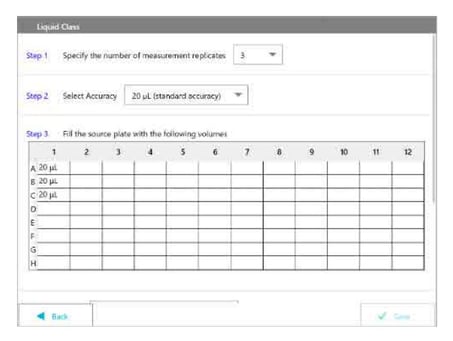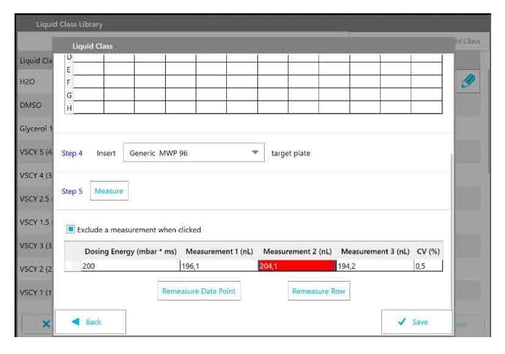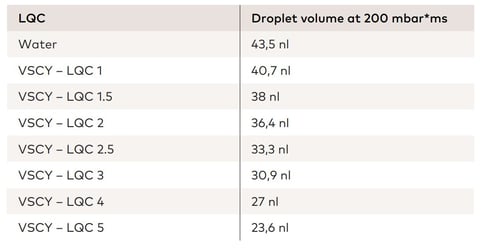The I.DOT L Liquid Handler is a high throughout non-contact liquid handler equipped with 96 large reservoir source wells to extend the source volume throughput. With an increase from 80 µl to 500µl per single source well the total dispensing volume is increased from 7680 µl to 48000µl. This allows to dispense from ultra -low volumes up to high liquid transfers.
The I.DOT Non-Contact Dispenser uses eight individually controlled pressure channels that can generate up to 100 droplets per second giving control and speed to the users while saving time and costs. It supports multiple liquid classes that can be applied to each individual well to maintain high flexibility for the protocol set-up.
Providing eight different viscosity liquid classes (VSCY LQC) the I.DOT L Non-Contact Dispenser already covers the full range of liquid classes with a maximum inaccuracy of 5%, if a liquid does not cover exactly one of the VSCY LQC. The liquid can simply be classified by the liquid class manager without having to create a liquid class for each.
1. Enter the Liquid Class Manager

2. Measure the droplet volume at 200mbar*ms
Define the number of measurement replicates and the accuracy and fill in the defined volume into the wells displayed.

Insert a target plate and click on Measure. If required, measurements can be excluded to obtain a lower CV (%). Excluded measurements will be displayed in red.
If necessary, single data points or a whole row can be remeasured. If you see any dead volume after the first measurement, leave it in the well and repeat the measurement with the dead volume inside the will. If this would not be done too less volume would be dispensed. By clicking on save, the best fitting liquid class will be
applied to the liquid.

Overview of the droplet volume at 200mbar*ms for the single viscosity liquid classes
The measured mean droplet volume will be compared with the values in the table and the best fitting Viscosity Liquid Class with the value closest to the measured droplet volume will be chosen.

3. Verification of the liquid class
To ensure that the Viscosity Liquid Class is fitting to the sample liquid the Dropcount protocol with the respective Viscosity LQC should be performed.
- Open the protocol Dropcount I.DOT L.idox, apply the liquid class that was defined for your liquid and insert adapter plates into the target tray to dispense on.
- Fill the dispensing well with 22 μL of the sample liquid and start the first measurement. If you see any dead volume after the first measurement, leave it in the well and repeat the first measurement – continue with the dead volume
inside the well – if this would not be done too less volume would be dispensed.
- It is of utmost importance to use a calibrated pipette for those measurements and to pipette exactly 22 μL into the well to perform this test with the highest accuracy!
- The software will calculate a filling volume of 26.4 μL, but the purpose of this measurement is to dispense exactly 100 droplets, which can be realized by filling the well with 22 μL.
- Count the dispensed droplets on the target plate. The deviation between the counted droplets to the desired 100 droplets is the deviation of the accuracy.
- Depending on the respective accuracy goal (we claim for 5%) the counted droplets should be between 95 and 105.
- Is the droplet number too high (>105 droplets) the next higher Viscosity LQC should be used; is the droplet number too low (<95 droplets) the next lower Viscosity LQC should be used.
Download our flyer or watch a demo video to learn more about the I.DOT Liquid Handler.